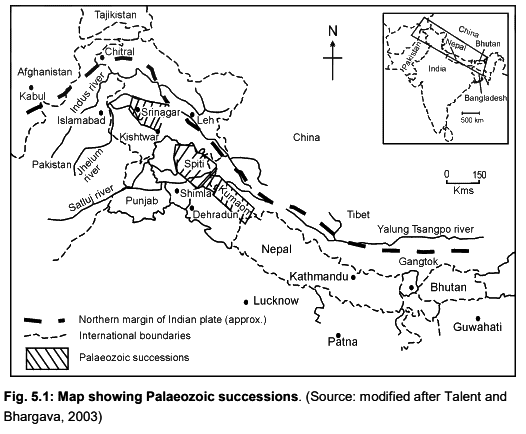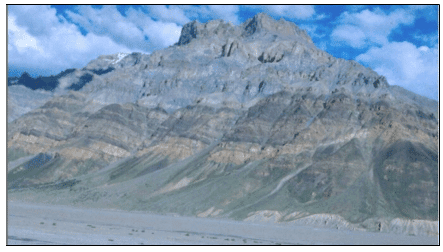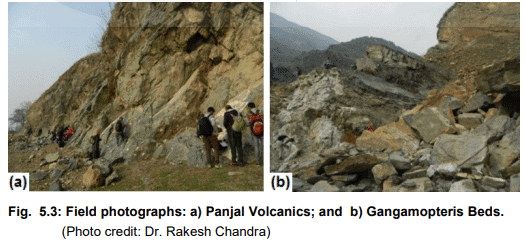UPSC Exam > UPSC Notes > Geology Optional for UPSC > Palaeozoic of India
Palaeozoic of India | Geology Optional for UPSC PDF Download
| Table of contents |

|
| Introduction |

|
| Palaeozoic Successions of Northwestern Himalaya |

|
| Palaeozoic Succession of Spiti |

|
| Palaeozoic Successions of Kashmir |

|
Introduction
The Palaeozoic successions of India include rock systems that were formed during the Palaeozoic era, which spans from the Cambrian to the Permian period. Throughout this era, India primarily experienced marine deposition, mainly occurring in the Himalayan region under the Tethys Sea.Palaeozoic Marine Successions
- These marine successions from the Palaeozoic are nearly absent in peninsular India, with only a few occurrences in places like Umaria and Jabalpur in Madhya Pradesh, and the Bikaner-Nagaur area in Rajasthan.
- In contrast, Palaeozoic successions are well-developed in various parts of the Himalayan region, including Kashmir and Zanskar in Jammu and Kashmir, Spiti in Himachal Pradesh, as well as in Uttarakhand and Arunachal Pradesh.
- The finest exposures of Palaeozoic rocks are found in the Spiti and Kashmir regions of the Himalayas.
Upper Palaeozoic Freshwater Sediments
- Freshwater sediments from the Upper Palaeozoic era (Carboniferous to Permian) were deposited in peninsular India and are part of the Gondwana Supergroup.
Palaeozoic Successions of Northwestern Himalaya
The Himalayan range is one of the longest mountain chains in the world, stretching over 2500 km from the Pamir region in the west to the Mishmi Hills in the east, located in the northern part of India. Its width varies from 150 to 400 km.The Himalayas are divided into two sectors from west to east: the northwestern Himalaya and the northeastern Himalaya.
- Northwestern Himalaya: This sector refers to the western half of the Himalayan mountain range, extending from northeastern Afghanistan through Kashmir to Nepal.
- Northeastern Himalaya: This sector covers the eastern part of the Himalayas, situated between the Kali Gandaki River in central Nepal (west) and Myanmar (east). It includes southeast Tibet, Sikkim, North Bengal, northeast India, and Bhutan.

- The Palaeozoic rock layers in northern India are well preserved within the Tethyan Himalayan basin located in the northwestern Himalayas.
- These rock formations are found in several areas, including the Kashmir basin, Spiti-Zanskar basin, and Kinnaur-Uttarkhand (Kumaon) basin.
- Additionally, Palaeozoic rocks can also be found in Bhutan, which is part of the northeastern Himalayas.
- The Lesser Himalayas also have some Palaeozoic rock sequences, found in regions such as Himachal-Uttarkhand and Nepal in the northwestern part, as well as in Darjeeling, Arunachal Pradesh, and Bhutan in the northeastern area.
- Among these locations, the Kashmir and Spiti basins have the most complete examples of Palaeozoic rock sequences.
Question for Palaeozoic of IndiaTry yourself: Which region in India has the most complete examples of Palaeozoic rock sequences?View Solution
Palaeozoic Succession of Spiti
- Location and Geography: Spiti is located in the Lahaul and Spiti District of Himachal Pradesh, in the northwestern part of the Himalayan region. This district is flanked by two mountain ranges, the Pir Panjal and the Greater Himalaya, which run from northwest to southeast. The two ranges are separated by the Lahaul and Spiti valleys.
- Geological Significance: The Spiti valley features a complete and well-preserved geological succession that dates from the Palaeozoic to Mesozoic eras. This succession is characterized by folded marine deposits rich in fossils. It is exposed along the northwest to southeast trend of the Himalayas.
- Fossil Assemblages: The geological succession in Spiti is renowned for its rich and diverse fossil assemblages, making it one of the best-studied Palaeozoic to Mesozoic successions in India.
- Museum of Indian Geology: Due to its significant geological and paleontological features, the Spiti area is often referred to as the “Museum of Indian Geology.” This nickname highlights its importance in the study of India’s geological history.

Lithostratigraphy
Haimanta Group:Cambrian Age- Location: Above the Precambrian Salkhala Formation and below the Thango Formation.
- Subdivisions: Batal Formation and Kunzam La Formation (also known as Parahio Formation).
- Batal Formation:
- Composition: Carbonaceous slates, phyllites, quartzites, and gritstones.
- Fossils: Lacks fossils.
- Kunzam La Formation:
- Composition: Slates, quartzites, calcareous quartzites, shales, limestones, dolomitic limestones, siltstones, and micaceous sandstones.
- Fossils: Contains trilobites, brachiopods, echinoderms, and pteropods.
- Distinction: Greenish color and gentle slopes differentiate it from Batal Formation.
- Age: Considered Cambrian, but Batal Formation may extend to uppermost Precambrian.
Thango Formation:Ordovician Age
- Location: Above the Kunzam La Formation of the Haimanta Group at a plane of angular unconformity.
- Composition: Thick conglomerates with intercalations of red clays, quartzites, shales, and limestones.
- Recognition: Prominent red color and rugged slopes.
- Fossils: Generally unfossiliferous, but contains brachiopods, bryozoans, trilobites, and cephalopods of Ordovician age.
- Environment: Marine deposition inferred.
Takche Formation:Silurian Age
- Location: Above the Thango Formation.
- Composition: Dominantly limestones and marls, with dolomites, siltstones, shales, and calcareous sandstones.
- Fossils: Rich in brachiopods, moderate yield of trilobites, rare mollusks, and fossils of corals, algae, and conodonts.
- Age: Considered Silurian, but basal part may be Upper Ordovician.
Muth Formation:Devonian Age
- Location: Above the Takche Formation.
- Composition: Hard, white quartzites with limestones, dolomites, and shales in the upper part.
- Thickness: Quartzite sequence about 150 m thick.
- Fossils: Largely unfossiliferous, but contains trace fossils and stromatolites.
Kanawar Group:Carboniferous Age
- Lipak Formation:
- Location: Above the Muth Formation, marked by the beginning of carbonate rocks.
- Composition: Hard and black fossiliferous limestones, shales, sandstones, and gypsiferous limestones.
- Fossils: Conodonts, ostracods, corals, trilobites, bivalves, and brachiopods.
- Age: Possibly uppermost Devonian to Lower Carboniferous.
- Po Formation:
- Composition: Interbedded shales and quartzites with siltstones.
- Fossils: Plant fossils of Lower Carboniferous age and brachiopods, bryozoans of Upper Carboniferous age.
- Age: Lower to Upper Carboniferous.
Kuling Group:Permian Age
- Ganmachidam Formation:
- Location: Basal unit of Permian strata, gradational contact with Po Formation.
- Composition: Polymictic conglomerates, quartzites, siltstones, and shales.
- Fossils: Brachiopods, bryozoans, and bivalves.
- Age: Uppermost Carboniferous to Lower Permian.
- Gechang Formation:
- Composition: Sandstones with thin bands of shales and conglomerates.
- Age: Lower Permian based on bivalves and corals.
- Gungri Formation:
- Location: Topmost unit of Kuling Group, above Gechang Formation and below Lilang Group.
- Composition: Black shales, silty shales, gray siltstones with phosphate and calcareous nodules.
- Distinction: Ferruginous layer at the top, gentle slopes, and black color.
- Fossils: Brachiopods, cephalopods, and palynomorphs.
- Age: Upper Permian.
Palaeozoic Successions of Kashmir
The Kashmir Valley in the Jammu and Kashmir state of India contains a continuous and well-preserved marine sedimentary record from the Palaeozoic era. This valley, which is about 135 km long and 40 km wide, is situated between the Zanskar Range (or Greater Himalayan Range) to the northeast and the Dhauladhar-Pir Panjal Range to the southwest. The valley trends from northwest to southeast and is bordered by the Draba and Karnah mountain ranges. The Palaeozoic succession in Kashmir primarily consists of fossil-rich marine rocks dating from the Cambrian to the Permian periods. These rocks are characterized by complex folding, forming anticlines and synclines, and are exposed along the Greater Himalayan and Pir Panjal ranges. However, there are some stratigraphic breaks in the sequence, indicating disconformities during the Upper Cambrian-Lower Ordovician, Devonian, and Upper Carboniferous periods.Key Geological Features
- Cambrian Rocks: Best exposed in the Lolab Valley, particularly in the Handwara and Kupwara regions.
- Ordovician and Silurian Rocks: Found in the Lidder Valley of Anantnag District.
- Devonian, Carboniferous, and Permian Rocks: Prominently seen in the Zewan area of Pulwama District, Lidder Valley in Anantnag District, and the Pir Panjal Range north of Banihal.
Lithostratigraphy
The Palaeozoic rocks in Kashmir are not only well-developed but also rich in fossils, attracting the attention of many researchers worldwide. The study of Palaeozoic stratigraphy in Kashmir dates back to 1866, with significant contributions from various geologists over the years. The Palaeozoic succession is situated above the Precambrian Dogra Slates/Salkhala Formation and below the Triassic Sonamarg Group.Hapatnar Group
- Overview: The Cambrian sequence in Kashmir is known as the Hapatnar Group, resting over either the crystalline rocks of the Salkhala Formation or the Dogra Slates.
- Precambrian Basement: These Precambrian rocks form the basement for the deposition of Tethyan sediments. The Salkhala Formation consists of argillaceous rocks in southwest Kashmir, while the Dogra Slates comprise a thick sequence of argillaceous rocks in the Poonch region.
- Cambrian Hapatnar Group: Divided into three formations: Lolab, Shumal, and Rangamal, in ascending order.
- Lolab Formation: The basal formation, resting over the Salkhala Formation along a non-conformity. Composed of siltstones, laminated shales, and sandstones, with sedimentary structures like cross-bedding and ripple bedding.
- Fossil Evidence: The Lolab Formation has yielded trilobites indicating a Lower Cambrian age, such as Redlichia teooensis, Chittidilla plana, and Yuehsienszella szechuanensis.
- Shumal Formation: Lies conformably above the Lolab Formation and below the Rangamal Formation. Composed of gray shales and siltstones, with sedimentary structures like ripple marks and cross-bedding.
- Fossil Evidence: Contains a rich assemblage of trilobites indicating a Middle Cambrian age, such as Xingrenaspis dardapurensis, Tonkinella breviceps, Bailiella lantenoisi, Parachittidia kashmirensis, and Shahaspis himalayensis.
- Rangamal Formation: Composed of siltstones, shales, sandstones, and limestones, with fossils indicating an Upper Cambrian age, including trilobites, bivalves, gastropods, and algae.
- Environmental Context: Deposited from subtidal to supratidal environments. The Shumal and Rangamal formations are equivalent to the Kunzam La Formation in the Spiti region.
Rishkobal Group
- Overview: The Ordovician and Silurian rocks of Kashmir are known as the Rishkobal Group, comprising two formations: Hallamulla and Gugaldhar.
- Hallamulla Formation: Lies abruptly above the Rangamal Formation, consisting of gray to green siltstones and purple-green shales. Fossils include crinoids and brachiopods, indicating a Lower Ordovician age.
- Gugaldhar Formation: Conformably overlying the Hallamulla Formation, composed of cross-bedded sandstones, calcareous shales, and bands of limestones. Fossils include corals, trilobites, brachiopods, and mollusks, suggesting an Upper Ordovician to Lower Silurian age.
- Equivalent Formation: The Gugaldhar Formation is considered nearly equivalent to the Takche Formation in the Spiti basin.
Lidder Group
- Overview: The Devonian to Lower Carboniferous sediments in Kashmir are referred to as the Lidder Group, comprising the Muth Formation, Syringothyris Limestone, and Fenestella Shale in ascending order.
- Muth Formation: Also known as Muth Quartzites, it rests unconformably over the Gugaldhar Formation, consisting of white quartzites, siltstones, shales, and dolomitic limestones. Fossils include brachiopods of the genus Dalmanella, indicating a Lower to Middle Devonian age.
- Syringothyris Limestone: Conformably lies above the Muth Formation, consisting of gray to dark blue limestones with bands of shales, quartzites, and traps. Fossils include brachiopods, bivalves, algae, corals, bryozoans, conodonts, and plant fossils, indicating a Devonian to Lower Carboniferous age. This formation is correlated with the Lipak Formation in Spiti.
- Fenestella Shale: Also known as Ganeshpur Formation, it rests over the Syringothyris Limestone, consisting of alternating beds of fossiliferous shales and unfossiliferous quartzites with rare bands of carbonates. Fossils include brachiopods, bryozoans, bivalves, corals, and rare trilobites and crinoids, with Fenestella being a dominant genus. This formation is dated as Lower Carboniferous and correlated with the Po Formation in Spiti.
Agglomeratic Slate
- Overview: The Upper Carboniferous rocks of Kashmir are known as Agglomeratic Slate, conformably overlying the Fenestella Shale. This formation consists of pyroclastic and ash material mixed with sediments, bearing angular fragments of various rocks and minerals.
- Lithological Composition: Composed of slates, sandstones, quartzites, conglomerates, tilloids, and bands of limestones.
- Fossil Content: Generally devoid of fossils, but some beds yield remains of brachiopods (such as Syringothyris, Linoproductus, Spirifer, Buxtonia ), bryozoans (notably Fenestella ), and bivalves (including Eurydesma, Pinna, Lima ).
- Equivalent Formation: Agglomeratic Slate is also referred to as Pindahol Formation and correlated with the Gechang Formation in Spiti.
- Environmental Context: Deposited in a fluvio-glacial to deltaic environment, with an Upper Carboniferous age.
Panjal Volcanics and Zewan Formation
- Panjal Volcanics: The Permian rocks in Kashmir begin with the Panjal Volcanics, consisting of basaltic andesite lava flows and ash beds. These volcanic activities persisted intermittently through the Permian and into parts of the Triassic, with the main event occurring in the Lower and Middle Permian. The Panjal Volcanics conformably overlie the Agglomeratic Slate and are primarily found along the central axis of the Pir Panjal Range. A Lower Permian age is assigned to these volcanic rocks.

- Zewan Formation: Rests over the Panjal Volcanics and comprises marine fossiliferous limestones, shales, and calcareous sandstones. Named after the Zewan village in the Vihi area of Kashmir, where it is well exposed, the Zewan Formation yields a rich fossil assemblage, including brachiopods (such as Linoproductus, Waagenoconcha, Neospirifer, Spiriferella, Dielasma, Lamnimargushimalayensis ), bivalves, bryozoans (like Protoretepora, Fenestella ), corals, ammonoids (including cyclolobus, Xenaspis ), crinoids, and conodonts. An Upper Permian age is assigned to the Zewan Formation, which is overlain by the Triassic Sonamarg Group.
The document Palaeozoic of India | Geology Optional for UPSC is a part of the UPSC Course Geology Optional for UPSC.
All you need of UPSC at this link: UPSC
|
64 videos|135 docs
|
FAQs on Palaeozoic of India - Geology Optional for UPSC
| 1. What are the main characteristics of the Palaeozoic succession in the Northwestern Himalaya? |  |
Ans. The Palaeozoic succession in the Northwestern Himalaya is characterized by a diverse range of sedimentary rocks, including marine and continental deposits. This succession includes formations such as the Spiti Shale and the Zanskar series, which exhibit evidence of ancient marine environments, volcanic activity, and tectonic movements. The lithology typically varies from shales and limestones to sandstones and conglomerates, indicating a complex geological history influenced by various tectonic events.
| 2. How does the Palaeozoic succession of Spiti differ from that of Kashmir? |  |
Ans. The Palaeozoic succession of Spiti is primarily composed of well-preserved marine sediments, including deep-sea deposits and fossils indicative of a rich biodiversity during that era. In contrast, the Kashmir Palaeozoic succession includes a mix of marine and terrestrial deposits, with significant evidence of glacial activity and continental sedimentation. This difference highlights the varying paleoenvironmental conditions and geological processes that shaped these regions during the Palaeozoic era.
| 3. What are the significant fossil findings in the Palaeozoic successions of India? |  |
Ans. Significant fossil findings in the Palaeozoic successions of India include a variety of marine organisms such as brachiopods, trilobites, and corals, especially in the Spiti region. These fossils provide crucial insights into the biodiversity and ecological conditions of ancient marine environments. Additionally, plant fossils found in the Palaeozoic strata of Kashmir indicate the presence of early terrestrial flora, highlighting the transition from marine to terrestrial ecosystems during this period.
| 4. What is the geological significance of studying Palaeozoic successions in India for UPSC aspirants? |  |
Ans. Studying Palaeozoic successions in India is of geological significance as it helps to understand the tectonic evolution, sedimentary processes, and paleoenvironmental conditions of the region. For UPSC aspirants, knowledge of these successions is essential for questions related to geology, paleontology, and the historical context of India's landforms. Moreover, it provides insights into India's natural resources and mineral wealth, which can be crucial for environmental and geological assessments in various examinations.
| 5. How does the Palaeozoic era influence the current geology and ecology of the Northwestern Himalaya? |  |
Ans. The Palaeozoic era has significantly influenced the current geology and ecology of the Northwestern Himalaya through the formation of various rock types and the development of unique landforms due to tectonic uplift and erosion. The sedimentary layers formed during this era contribute to the region's mineral resources, while the fossil records provide insights into the evolutionary history of the area's flora and fauna. This geological history also shapes the present-day ecology, as the diverse habitats created by these geological formations support a wide range of biodiversity in the region.
Related Searches



















